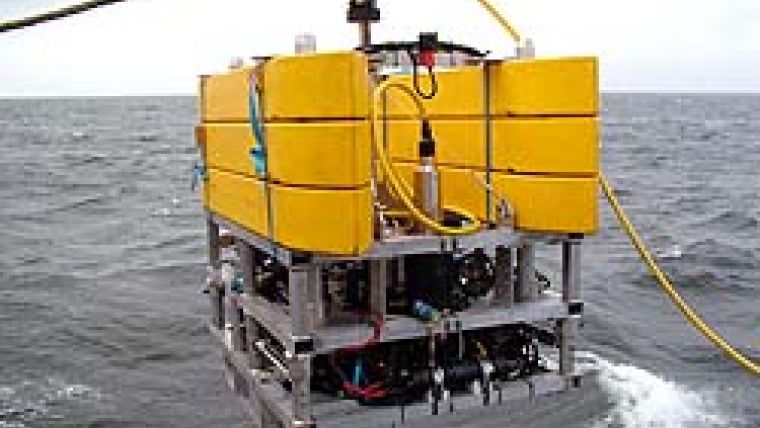New ROV Shines after Weathering Storm
This month we report on the maiden cruise of the ROVLATIS that took place at the beginning of March 2009 aboard the R/V Celtic Explorer. Its designers – the Mobile & Marine Robotics Research Team from the University of Limerick – led a multi-disciplinary, multi-purpose complement of scientists from Ireland and Germany. We followed the team as they found out how the fully integrated vehicle performed in challenging sea conditions.
Mobilising from Galway, the ship headed into Galway Bay. However, due to wintry conditions, some of the trials were performed in more sheltered waters near Rossaveel, between the Aran Islands and the Connemara mainland. This is a Gaeltacht region where native Irish is still the predominant spoken language!
After ship connections were verified, all on-board instrumentation and sensor systems were enabled and their operation was checked thoroughly before the go-ahead was given to launch the vehicle (Figure 1).
One of the first tasks was alignment of the fibre-optic gyroscope and Doppler velocity log. The ROV was deployed and operated on the surface with differential GPS antenna attached. Maintaining a steady heading alongside the ship into the weather for a 2km transect proved difficult, with wave motion pitching and rolling the vehicle. After the ROV was taken under tow (one of its designed modes of operation), alignment converged.
With the release of floatation, the vehicle displayed excellent weight distribution and near-neutral buoyancy. The pilot then used the ROV's rapid auto-tuning capability to tune the position and speed controllers, giving him precise control of the vehicle in 6 degrees of freedom. Beneath the surface, conditions were less rough and the vehicle was navigated with a joystick in the cabin using the in-house developed visualisation and control tools together with on-board cameras. The pilot was able to rely on the computer screens to get accurate feedback on the vehicle's motion, position and proximity to the ship and seabed (Figure 2).
The unique fault-tolerant thruster control system of ROVLATIS was unexpectedly triggered when a connection to one of the thrusters became loose. As predicted, the loss of power was detected immediately and the control system automatically reallocated power to the other thrusters providing the necessary compensation to allow the vehicle to continue on the desired course.
After working around unforeseen latency and time-stamping problems, a demonstration of the new multi-sonar controller also went well. Individual data sets were captured from side-scan and multi-beam sonars in separate survey passes over the same area. These were then compared with a combined data set captured in a third pass using the unique interleaving algorithm. This test showed that adaptive ping control is possible over variable depths and that a time saving of at least 30% can be achieved with co-registration of data sets guaranteed. Post-processing is now under way to measure the improvement in data set features identified.
Descending to within 2m of the seabed, colour zoom low light monochrome cameras were used to capture imagery of different terrains and to inspect a tangled sea buoy. Superb data sets were captured for vision-based near-seabed navigation.
Despite and because of the challenges faced, the cruise proved a great success. All vehicle sub-systems were tested, and operability and environmental setbacks were overcome. The team looks forward to publishing more detailed results once further analysis of the recorded data is complete (Figure 3).
The Mobile & Marine Robotics Research Centre (MMRRC) has grown out of the Department of Electronic & Computer Engineering at the University of Limerick (Ireland, see the Business article in Hydro international, March 2009).
Dr Daniel Toal, director, Mobile & Marine Robotics Research Centre (Ireland) Simon Marr, marketing, Mobile & Marine Robotics Research Centre (Ireland)

Value staying current with hydrography?
Stay on the map with our expertly curated newsletters.
We provide educational insights, industry updates, and inspiring stories from the world of hydrography to help you learn, grow, and navigate your field with confidence. Don't miss out - subscribe today and ensure you're always informed, educated, and inspired by the latest in hydrographic technology and research.
Choose your newsletter(s)
























